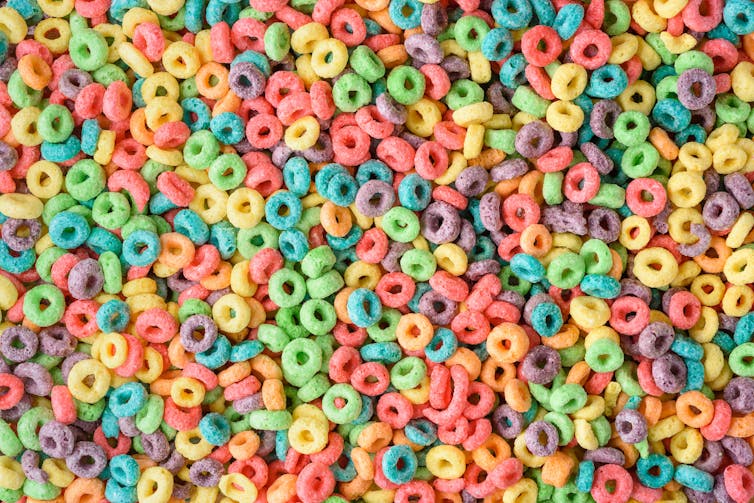Pink 3 – additionally referred to as FD&C Pink No. 3, erythrosine or E127 – has been extensively utilized in meals, cosmetics and prescription drugs since its FDA approval in 1969. You’ve seemingly encountered Pink 3 earlier than. It’s a standard additive to many candies, drinks, baked items, cereals, maraschino cherries and gelatin desserts, in addition to sure drugs, syrups and cosmetics.
Nevertheless, mounting scientific proof means that consuming Pink 3 poses important well being dangers. These dangers prompted California to ban its use in meals in 2023 and the Meals and Drug Administration to ban its use in each meals and prescription drugs nationwide on Jan. 15, 2025.
As a researcher finding out irritation and most cancers, I examine how artificial meals dyes have an effect on human well being. Stricter laws mirror rising issues over the damaging physiological results of Pink 3 and different artificial dyes in your physique, together with inflicting most cancers.
Well being dangers of Pink 3
Over the previous 35 years, an growing quantity of scientific proof has recognized the damaging well being results of Pink 3. Whereas researchers haven’t but established a direct hyperlink between Pink 3 and most cancers in folks, substantial proof from animal research factors to its carcinogenic potential.
First, Pink 3 disrupts thyroid hormone regulation by means of a number of mechanisms. It inhibits the thyroid gland’s capacity to soak up iodine, a key part for synthesizing thyroid hormones, and blocks an enzyme important for changing one thyroid hormone to a different, contributing to thyroid dysfunction. Together with different impairments in thyroid hormone perform, Pink 3 will increase the chance of thyroid-related problems.
A number of animal research have linked Pink 3 to thyroid dysfunction and most cancers.
Marat Musabirov/iStock by way of Getty Pictures Plus
Second, Pink 3 might promote thyroid tumor formation. A number of research exposing rats and pigs to Pink 3 noticed enlarged tumorous thyroid glands and abnormalities in hormone regulation.
Third, Pink 3 can have poisonous results on the mind in a number of methods. Rat research have discovered that this artificial dye will increase oxidative stress, which damages tissues, and reduces the antioxidants that management oxidative stress, impairing communication between neurons. Research in rodents additionally discovered that Pink 3 triggers neuroinflammation that results in neuronal harm and dysfunction. Moreover, Pink 3 might work together with the amyloid-beta peptides linked to neurodegenerative circumstances like Alzheimer’s illness and worsen these circumstances.
Regulatory momentum
Pink 3 first confronted scrutiny within the Nineteen Eighties when a number of animal research linked it to thyroid tumors in male rats. This led to its 1990 ban in cosmetics within the U.S., though its use in meals continued below business stress. Whereas the European Union restricted using Pink 3 to solely sure kinds of processed cherries in 1994, the U.S. has lagged behind.
California’s 2023 ban of Pink 3 in meals, efficient in 2027, reignited debate on Pink 3 and its hyperlink to most cancers and spurred 24 organizations to advocate for federal motion.
A number of international locations have banned using Pink 3 in meals. Till January 2025, the U.S. had solely banned it in cosmetics and topical medicine.
This debate culminated within the FDA’s nationwide ban in January 2025. Whereas the FDA cites no direct proof of Pink 3’s carcinogenic impact in folks, it acknowledges that animal research present ample foundation for regulatory motion. The FDA’s resolution aligns with the 1958 Delaney Clause of the Federal Meals, Drug and Beauty Act, mandating a ban on components proven to trigger most cancers in people or animals.
Notably, it took over 35 years from the preliminary findings of thyroid most cancers in rodents to the eventual ban in 2025.
A path ahead
The development from Pink 3’s approval to its prohibition highlights the battle between industrial pursuits and public well being. Continued vigilance over Pink 3 may assist the nation prioritize client security.
Below the FDA’s mandate, producers should reformulate meals merchandise and ingested medicine to depart out Pink 3 by January 2027 and January 2028, respectively. Whereas some international locations nonetheless allow use of Pink 3, U.S. imports should meet home security requirements. Harmonizing world requirements on regulating and evaluating artificial dyes is crucial to guard client well being.

Stronger, extra standardized regulation of artificial meals dyes would assist defend client well being.
choness/iStock by way of Getty Pictures
A number of corporations promoting ultra-processed meals have begun the shift away from artificial dyes. In 2016, Mars introduced plans to take away all synthetic colours from its human meals merchandise over a five-year interval. In 2024, Common Mills introduced that it might remove synthetic colours and flavors from its merchandise.
Customers can defend themselves from Pink 3 publicity by studying ingredient labels for “FD&C Red No. 3” or “E127” and selecting merchandise that use pure dyes. Getting ready selfmade meals with pure shade options like beet juice or turmeric is an alternative choice. Supporting dye-free manufacturers and staying knowledgeable about regulatory adjustments can additional scale back your publicity whereas selling safer meals practices.
Ongoing analysis and coverage reforms targeted on public security may assist make sure that meals components like Pink 3 now not put client well being in danger.